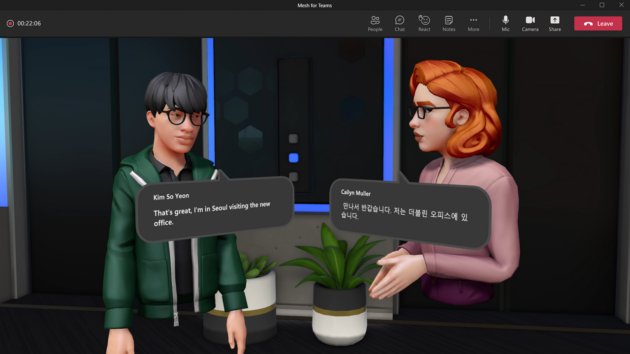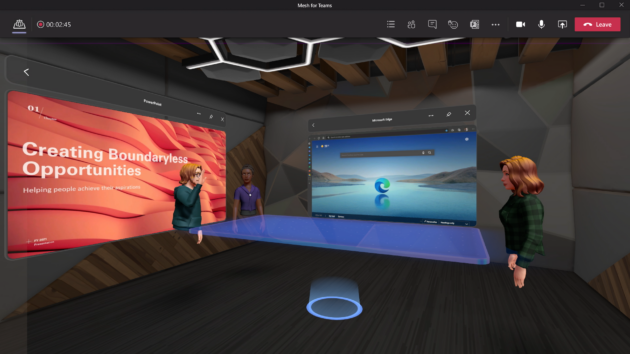The Mesh for Teams feature allows users to join meetings as their own custom avatar, shown here with camera participants. (Microsoft Image)
Microsoft presented its latest vision for the post-COVID workplace on Tuesday, addressing a buzzword that has become increasingly prominent in recent weeks: the metaverse.
At its Ignite 2021 virtual conference Tuesday morning, the company announced a new product called Mesh for Teams, which allows workers to take the form of avatars and navigate virtual work environments.
Microsoft said it combines “shared holographic experiences” with existing communication tools such as virtual meetings, discussions and shared documents. The software, which can be used with a smartphone, laptop or virtual reality device, is based on Microsoft’s existing Mesh technology, which the company first introduced earlier this year.
Permanent team meetings can be hosted in a virtual Mesh for Teams space that includes an interactive whiteboard, color-coded tasks, or photos of clients. Prototyping products can be placed on a virtual table.

Microsoft also announced the public preview of Dynamics 365 Connected Spaces, which provides data on how people interact with factory floors, retail spaces, and other physical work settings. Connected Spaces, formerly known as Dynamics 365 Connected Store, helps companies collect data from observed activity in a specific physical space, generate insights from that data using AI-based models, and then respond to trends and models.
Both technologies are examples of the metaverse, which has long been seen as a potential next iteration of the web.
Microsoft’s announcements come less than a week after Facebook announced that it would transform its business into a new parent organization known as Meta and expand its reach beyond social media to develop relevant experiences.
Metaverse, until recently the stuff of science fiction, remains a mysterious concept. Overall, it is an unlimited and interactive virtual environment, often imagined in 3D, in which humans take the form of avatars.

The term was first introduced in Neil Stephenson’s 1992 science fiction novel, “Snow Crash,” and the concept has appeared in other books and films, including “Ready Player One” and “The Matrix.” In fact, metaverse prototypes include online multiplayer games such as Fortnite, Grand Theft Auto, Roblox, and World of Warcraft.
Frank X Shaw, Microsoft’s Vice President of Communications, wrote in a blog post that the metaverse is “a continuous digital world connected to many aspects of the physical world, including people, places, and things.”
In other words, it is a new vision of the Internet that uses augmented reality, virtual reality, and existing technology to create new and immersive ways for humans to interact with each other as well as with the human physical world.
Microsoft, for example, said that its cloud software is now able to connect with Internet of Things (IoT) devices in a way that creates a “digital twin” of the device in the virtual world. Changes made to the virtual machine in the cloud – or, if you prefer, the metaverse – correspond to changes made to the actual physical machine. In this way, a group of engineers scattered around the world can meet in a virtual space and solve a problem with the plant’s equipment.
Shaw wrote that the metaverse equals “a new medium and some sort of application”.
“The metaverse enables the exchange of experiences in both the physical and digital worlds,” he wrote, adding that as companies continue to rely on software in a post-COVID world, “the metaverse can help people meet in a digital environment, make meetings more comfortable with avatars, and facilitating creative collaborations from around the world.
Microsoft is expanding cloud-based applications, including Teams and Dynamics 365, as its cloud business continues to support business results. Revenue from Microsoft Cloud, formerly Commercial Cloud, increased 36% to $20.7 billion last quarter, surpassing $20 billion in a quarter for the first time in the company’s history.
Microsoft CEO Satya Nadella described today’s Ignite announcements as “the next chapter in the Microsoft cloud, and how we’re building it for the next era.”

Microsoft and Facebook’s adoption of the metaverse is a huge step forward in a new way of interacting with technology and other humans.
These efforts are also not surprising as the COVID-19 pandemic enters its second year. The pandemic has given a boost to the development of collaboration programs and companies’ adoption of cloud technologies, as most knowledge workers are forced to self-isolate and work remotely. This was the biggest change in the way we work since the advent of the computer.
However, assuming the metaverse concept continues to gain traction, it will take time to develop its infrastructure, including new camera sensors in laptops and smartphones, as well as to adapt web social media, e-commerce and other services to a new medium . Information last week speculated that the Metaverse could be worth $82 billion by 2025.
However, Facebook founder Mark Zuckerberg said last week that he plans to eventually reach the billion people and achieve “hundreds of billions of dollars in digital commerce every day.”
Meanwhile, Facebook and Microsoft executives are taking a kind of hybrid approach, where metaverse technologies are available in one form or another on all existing devices and as an option that expands – rather than replaces – the technologies. Today.
No doubt Facebook’s Oculus virtual reality division, which was acquired in 2014, will help him build his metaverse vision. But Microsoft has many strengths to apply to developing metaverse technologies, including widely used enterprise productivity software, Azure cloud infrastructure, Surface laptops and tablets, and the HoloLens mixed reality headset.
Microsoft is turning to the metaverse as a potential solution to a thorny post-pandemic problem: As offices begin to reopen, many employees want to continue working remotely at least on certain days of the week. At the same time, companies are trying to maintain the benefits of face-to-face interaction and to preserve the corporate culture.
“The ability to work from anywhere and connect with colleagues online is great, but remote meetings can feel impersonal and miss the little moments that build relationships and jobs,” Microsoft said in an article. The Mesh for Microsoft Teams blog post was published on Tuesday.
Microsoft said that many online meetings proved to be “awkward and two-way” — once colleagues saw it in the form of a still image or a bubble containing their initials.
The Mesh for Teams app is expected to launch in the first part of next year.

“Certified gamer. Problem solver. Internet enthusiast. Twitter scholar. Infuriatingly humble alcohol geek. Tv guru.”




